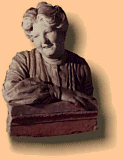 |
Some artists
of the Kiln |
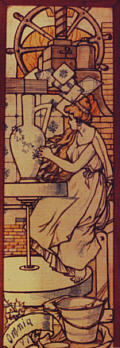 In the period from
1880 to 1960 many artists were at work in the Guerra-Gregorj Kiln. Many of these
cultivated various forms of art, in a manner independent from the collaboration of the
kiln, and obtained rewards and success even outside of the industrial art. Here we recall
these artists only for the activity and the works done with the artistic production of the
kiln.
In the period from
1880 to 1960 many artists were at work in the Guerra-Gregorj Kiln. Many of these
cultivated various forms of art, in a manner independent from the collaboration of the
kiln, and obtained rewards and success even outside of the industrial art. Here we recall
these artists only for the activity and the works done with the artistic production of the
kiln.
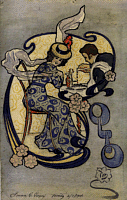 Among those that were
working between the end of the 1800's and the early 1900's, Angelo Bonotto, Piero
Murani, Cesare Laurenti, A. G. Rosa, Giuseppe Rosetti from Faenza colled
"The Motino"
and Luigi Serena, were notable.
Among those that were
working between the end of the 1800's and the early 1900's, Angelo Bonotto, Piero
Murani, Cesare Laurenti, A. G. Rosa, Giuseppe Rosetti from Faenza colled
"The Motino"
and Luigi Serena, were notable.
Angelo Bonotto. Bonotto worked in the last years of the nineteenth century. He depicted country landscapes, Venetian panoramas, and themes of neo-classical inspiration.
Piero Murani.
From the hands of Murani sprung graceful figures of the Art Deco style, which illustrated a harmonious and serene vision of life: portraits, decorative panels, fantastic figurations as ornaments for buildings, salons and sacred buildings. A serene art which could not have been more different from that incisive and revolutionary style of the young Arturo Martini.He entered the ceramics plant at a very young age, lived the first artistic experiences at the side of Angelo Bonotto, demonstrating very early on his personal and harmonious interpretation of reality. This reality was tied in part to the vision of art nouvelle comparable to that of Alphonse Mucha (1860 – 1939), the great Bohemian artist who went from Vienna to Munich to Paris, which he reached in 1887, so much did he influence the art of his time. Murani always maintained in his pictorial stroke a greater degree of serenity.

 Many of
his works were completed in the artist's salon where he composed portraits and decorative
panels which were submitted to and won awards in many expositions, from that of Sacred Art
in Turin in 1898 to the Universal Exposition in Paris in 1900 to the Exposition of
Brussels in 1910. He worked alongside Professor Carlini and Cesare Laurenti leaving many
sketches, drawings, oils and watercolours where he often signed his initials P.M. in a
four leaf clover which rarely appeared in the ceramic panels. The insurmountable contrast
with the younger Arturo Martini, both working toward the realisation of the two Christs in
the same period, led Murani to leave the kiln and continue his work in the Laurenti studio
in Venice.
Many of
his works were completed in the artist's salon where he composed portraits and decorative
panels which were submitted to and won awards in many expositions, from that of Sacred Art
in Turin in 1898 to the Universal Exposition in Paris in 1900 to the Exposition of
Brussels in 1910. He worked alongside Professor Carlini and Cesare Laurenti leaving many
sketches, drawings, oils and watercolours where he often signed his initials P.M. in a
four leaf clover which rarely appeared in the ceramic panels. The insurmountable contrast
with the younger Arturo Martini, both working toward the realisation of the two Christs in
the same period, led Murani to leave the kiln and continue his work in the Laurenti studio
in Venice.
Cesare Laurenti. In the kiln, his hands produced a great frieze in multicoloured ceramic, which was exhibited at the Biennale of Venice in 1903 and was acquired by the City of Venice for its Gallery of Modern Art. This represented an homage to the ideal of classical beauty with a wide shot of the most famous people represented in the Italian art world, beginning with the "temple of gold" where the statues of the most important sculptors of antiquity stand out and which is considered the source of inspiration and renewal. The frieze, of very large dimensions (52.50 x 1.20 metres), was done in the high heat fired kilns. After many events took place, following the exhibition of original cartoons which had been kept for many years in the kilns under the care of the Historic Archives of the Biennale of Venice in 1977, this frieze was remounted in 1985 in the Castle of the Mesola in Ferrara, in tribute to Laurenti. Even Piero Murani collaborated on the difficult realisation of this project.
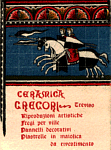 Antonio Carlini (1859-1945). A painter and sculptor, Carlini worked in the artist's salon, open
not only to employees of the kilns but also to every form of external collaboration with
the representatives of the culture.
Antonio Carlini (1859-1945). A painter and sculptor, Carlini worked in the artist's salon, open
not only to employees of the kilns but also to every form of external collaboration with
the representatives of the culture.
His are the decorations on various splendid vases representing scenes dealing with the medieval world. Carlini's contribution was notable on the occasion of the 50
th anniversary of the Italian Unification held in Rome in 1911, where a medieval environment was reconstructed in the Treviso room, dedicated to the Court of Love, and in the Venetian room dedicated to Saint Orsola. The participation was organised by the Veneto Committee of the Province of Treviso.Carlini also left sculptures inspired by daily life and watercolours. Of particular interest are his watercolour frescoes in the Loggia del Cavaliere in Treviso, using extraordinarily vivid colours which now have been almost completely erased by the passing of time and the problem of smog.
Guido Cacciapuoti (1892-1953). Guido Cacciapuoti, too, after having arrived in Treviso in the first years of the twentieth century, modelled clay into small sculptures of exquisite workmanship, choosing above all the representation of animals and succeeding in offering to this field of work a great deal of originality. He was quickly put in the spotlight at the Treviso Art Show in 1915, when he had already matured his collaboration with Gino Rossi, Arturo Martini and Arturo Malossi.
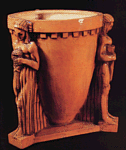 Arturo Martini (1889-1947). Among the young artists who put themselves to the test in the
factory, Martini was the one who following this would become the most famous of the
"Val Martin", as he loved to describe himself at the time in order not to be
confused with the more famous painter and graphic artist, Alberto Martini, who also
collaborated with the Kilns. Even in the small terracotta pieces and the tiles, he
exhibited a distinct originality. "Michelangelo and Me" affirmed the young
artist with a tone of superiority in comparison with the graceful and serene art of
Murani.
Arturo Martini (1889-1947). Among the young artists who put themselves to the test in the
factory, Martini was the one who following this would become the most famous of the
"Val Martin", as he loved to describe himself at the time in order not to be
confused with the more famous painter and graphic artist, Alberto Martini, who also
collaborated with the Kilns. Even in the small terracotta pieces and the tiles, he
exhibited a distinct originality. "Michelangelo and Me" affirmed the young
artist with a tone of superiority in comparison with the graceful and serene art of
Murani.
From the Bavarian period, (Gregrorio Gregorj sent Martini to study in Munich in 1909 paying for this out of his own pocket, even then predicting the evolution of this budding genius) witness is born in some letters between the entrepreneur and the artist, demonstrating in practical suggestions ("…you won't want to tie the plaster tiles with wire anymore, dear Martini…") and the unusually deferential tone, how much importance the "furnace worker", as he liked to call himself, attributed to the collaboration between art and industry.
 Martini
began his collaboration realising small terracotta pieces, for which he found inspiration
both in real events occurring in his lifetime and in themes of past mythology ( fallen
Icarus and the Statuette of Verdon). A note by Gregorio cites the "Statuette of
Tanagra" to consign to Martini. He produced decorated tiles of small dimensions,
stylised basins for which he was inspired by Aztec art, and ornamental vases with original
statements.
Martini
began his collaboration realising small terracotta pieces, for which he found inspiration
both in real events occurring in his lifetime and in themes of past mythology ( fallen
Icarus and the Statuette of Verdon). A note by Gregorio cites the "Statuette of
Tanagra" to consign to Martini. He produced decorated tiles of small dimensions,
stylised basins for which he was inspired by Aztec art, and ornamental vases with original
statements.
Martini finished his collaboration with the kiln in a abrupt manner, following a difference of opinion with Gregorio Gregorj about the execution of a basin. "Engineer, here are the tiles!" he said to Giorgio, seated in Piazza dei Signori, and with this Martini broke them on his head, fleeing as quickly as possible.
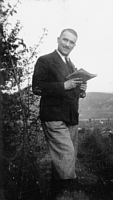 Mario Gregorj (1891-1973).
The activity of Mario Gregorj began in the early part of the twentieth century and kept
going until the closing of the kiln. Mario played an important role in the artistic
production of the kiln. Graduated in law and an Alpine soldier in the first world war (he
left sketches behind of the daily life of himself and his companions in the trenches)
Gregorj lived discreetly alternating between his professional activity and that of painter
and sculptor right up to his last days. He grew up in the school of the artists working in
the kilns and demonstrating even with his first works a preference for the renaissance
aesthetic ideal and choosing the harmonious representation of feminine figures. He then
moved to the capital in order to complete his training and worked as a medal carver in a
mint in Rome.
Mario Gregorj (1891-1973).
The activity of Mario Gregorj began in the early part of the twentieth century and kept
going until the closing of the kiln. Mario played an important role in the artistic
production of the kiln. Graduated in law and an Alpine soldier in the first world war (he
left sketches behind of the daily life of himself and his companions in the trenches)
Gregorj lived discreetly alternating between his professional activity and that of painter
and sculptor right up to his last days. He grew up in the school of the artists working in
the kilns and demonstrating even with his first works a preference for the renaissance
aesthetic ideal and choosing the harmonious representation of feminine figures. He then
moved to the capital in order to complete his training and worked as a medal carver in a
mint in Rome.
A pair of archers ornamenting a pavilion of the kilns, which even after many years has retained the harmonious blending of colours, and a sun-dial (this art used for calculating the time in which he was an expert) in Lancenigo, in the Villa Angarani delle Stelle, inspired by a fresco by Veronese representing the industry, are two of his admirable works. Many are his sculptures, drawings, and panels in multicoloured ceramic, some with sacred motifs. Among his writings, memorable are an essay on the perspective of the 1400's and an interesting artistic itinerary, both as yet unedited.
 Arturo Malossi (1893-1967). Made a valid contribution to artistic production by incrementing
production of both the decorative plates and the panels. He was inspirational to the
pictorial renewal between the two world wars, this renewal characterised by a more
simplified and linear design and afterwards greatly accentuated in the last years of the
kiln's activity by the metaphysical abstract style of Giuseppe Santomaso.
Arturo Malossi (1893-1967). Made a valid contribution to artistic production by incrementing
production of both the decorative plates and the panels. He was inspirational to the
pictorial renewal between the two world wars, this renewal characterised by a more
simplified and linear design and afterwards greatly accentuated in the last years of the
kiln's activity by the metaphysical abstract style of Giuseppe Santomaso.
 Malossi's collaboration with the kilns began
with the traditional decoration of plates in a fourteenth century style but then
continued, revealing a totally original new way of painting. Malossi participated in the
Treviso art exhibitions in 1924 and 1925 receiving on those occasions the silver medal.
Also notable were his works of sacred art, in particular angels, in which there was a
definitely modern touch. He especially loved the stylised representation of animals, even
the more exotic ones, much like his counterpart and friend, Cacciapuoti. With one of his
panels in varnished relief, Malossi took part in the Industrial Exposition in Barcelona in
1930 where the kiln obtained the gold medal.
Malossi's collaboration with the kilns began
with the traditional decoration of plates in a fourteenth century style but then
continued, revealing a totally original new way of painting. Malossi participated in the
Treviso art exhibitions in 1924 and 1925 receiving on those occasions the silver medal.
Also notable were his works of sacred art, in particular angels, in which there was a
definitely modern touch. He especially loved the stylised representation of animals, even
the more exotic ones, much like his counterpart and friend, Cacciapuoti. With one of his
panels in varnished relief, Malossi took part in the Industrial Exposition in Barcelona in
1930 where the kiln obtained the gold medal.

 Among the techniques he used, Malossi frequently used graffito and
was on a constant search for new mixes of colours and varnishes which he experimented in
his works. In the 1940's he began his collaboration with Piero Vaccari's Ceramics Industry
of Vicenza and until 1945 collaborated with the Fontebasso Manufacturers in Treviso.
Following this, Malossi worked with the Treviso Art Ceramics, founded by the Tommasini
family, Nino, Annamaria and Pina. He participated in 1948 in the Twenty-fourth Art
Exposition of Venice, entering his decorative plates into the competition and in 1962, in
the Thirty-first Art Exposition of Venice with his panels in refractory in graffito while
working for the Pagnossin Ceramics of Treviso.
Among the techniques he used, Malossi frequently used graffito and
was on a constant search for new mixes of colours and varnishes which he experimented in
his works. In the 1940's he began his collaboration with Piero Vaccari's Ceramics Industry
of Vicenza and until 1945 collaborated with the Fontebasso Manufacturers in Treviso.
Following this, Malossi worked with the Treviso Art Ceramics, founded by the Tommasini
family, Nino, Annamaria and Pina. He participated in 1948 in the Twenty-fourth Art
Exposition of Venice, entering his decorative plates into the competition and in 1962, in
the Thirty-first Art Exposition of Venice with his panels in refractory in graffito while
working for the Pagnossin Ceramics of Treviso.
Giuseppe Santomaso. Santomaso was one of the last to work in the artist's salon and introduced still another new essential style in the decoration of ceramics. He created a kind of special tile in relief, with stylised designs used for vestments and the decorations of buildings in the 1960's. Notable were the ones used for the decoration of the Antenore building in Padova and for the Rivoli theatre in Valdagno.
|